Category: Idaho Military Divison
Youth summer camp, yeah!
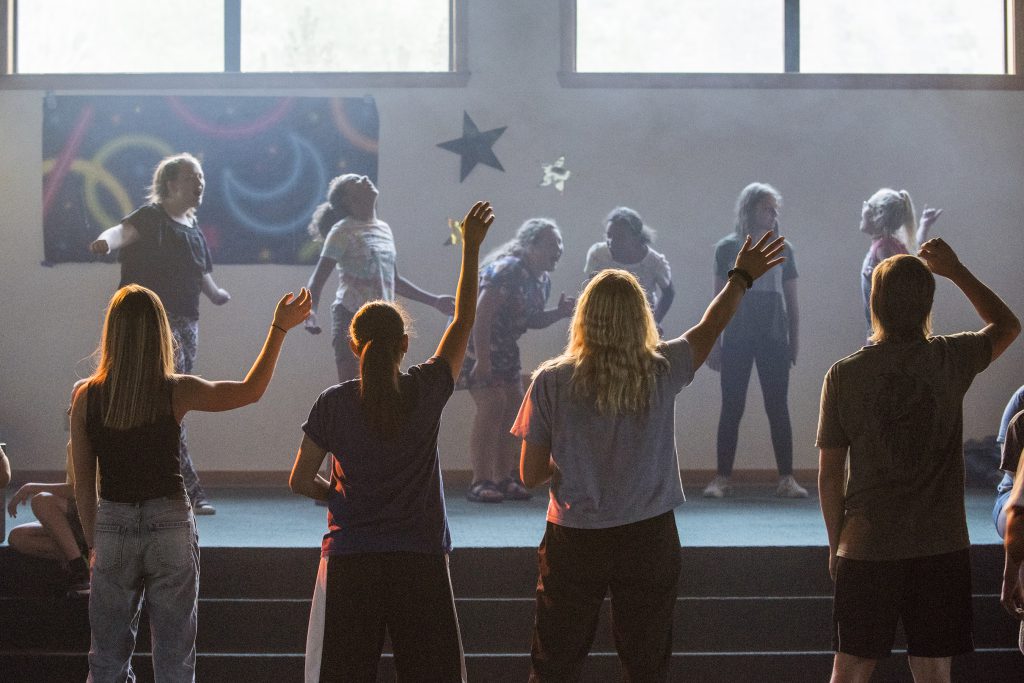
Idaho Military Division Public Affairs/Master Sgt. Becky Vanshur
The Idaho National Guard’s Service Member and Family Support held two Child and Youth Program summer camps in Challis, Idaho, during June. The annual camp took place over two weeks to accommodate COVID-19 protocols.
The camp was the first for military children ages 10 and up from around the state in more than 18 months. Youth from the Treasure Valley, Eastern Idaho and Northern Idaho joined together in Challis for a four-day, fun-filled camp that also taught them valuable lessons on friendship and resiliency.
“The camp is not just for fun, although it’s a ton of fun, but we also build resiliency training into our curriculum,” said Nick Wagner, Child and Youth Program coordinator. “This year in particular we focused on communication with the campers, because we haven’t had a camp for a year and a half and the youth may be struggling with that going back out into society after COVID. We wanted to bring that factor into this summer’s camp, to learn the communication needed to appropriately treat and respect our peers, opponents and our teammates.”
The Idaho National Guard has hosted summer and winter camps for more than 15 years and each year the coordinators work to continuously improve the program by closing each camp with a session that lets campers speak about what they liked or didn’t like about the camp.
“I like that you can always meet new friends and then you can see them at other camps or events,” said Ashton Danielson, a fourth-time camper whose dad serves in the Idaho Army National Guard at Gowen Field. “You’ll always have those friends but you can continue to meet new ones because if you see someone alone or that doesn’t have a friend, you go and include them. I like that about these camps.”
The program focuses on camp activities that help military youth grow, become more resilient and gain confidence. Each year they find more ways for activities to focus on the campers helping each other, motivating one another and working together while learning about sportsmanship, resiliency and coping with change during each challenge or activity.
Campers are broken into teams to allow for friendly competition and the sense of belonging to a group and working together for a common goal. They participate in events such vader ball, obstacle courses, archery tag, relay races, tug of war, 9-square, spike ball, yard games, basketball, volleyball, baseball and gaga ball. Additionally, campers were able to use their free time to create arts and crafts, make time capsules and learn 4-H activities with the Idaho National Guard’s College of Idaho 4-H partnership.
Campers also enjoyed a slip ‘n slide, performed campfire skits and had an end of camp dance party.
The camp continued to follow strict guidelines for COVID safety and protocol and held two camps broken down into smaller crowd numbers to accommodate these guidelines.
“We’ve had to get creative the past year and a half and come up with ways to reach out to our youth virtually,” said Wagner. “And this summer getting back into it, we had to break it into two camps to keep within the 50-person guidelines.”
During each camp, volunteers and chaperones ensure a safe and successful camp. Six teen counselors were present to help lead sessions, support resiliency, help make connections and provide positive influence for the youth. Wagner said the camp could not successfully run without the volunteers, teen counselors and chaperones.
“I have been coming to this camp as either a camper or volunteer for 15 years, for a total of 30 camps,” said Cloe Muthiora, a camp volunteer who was recognized recently with the 2020 National Guard Bureau Youth Development Volunteer Award for her time spent volunteering to the families of the Idaho National Guard. “I started coming when I was 10 and then came back as a chaperone once I was old enough and have been chaperoning ever since. This program is the reason I am who I am. I am a teacher now and I have leadership positions in other organizations because I grew up involved in this program, developing those skills. I started learning leadership skills when I was just 14, which gave me so many opportunities to explore who I wanted to be and become the best version of myself.”
The next camp will be the Winter Bash, held in January.
“Our Child and Youth Program is a great resource offered to military families,” said Command Sgt. Maj. Kevin Dean, Idaho Army National Guard senior enlisted leader. “I have been an advocate of this program ever since I had the pleasure of chaperoning a camp and that is when I came to fully support and promote this program. Whether it’s a summer camp, winter camp or a routine get together, this is a great opportunity for our kids to meet other military children who they can relate to with the struggles that sometimes comes with being a military kid compared to other kids in their community.”
Cancer can’t stop Guardsman from deploying
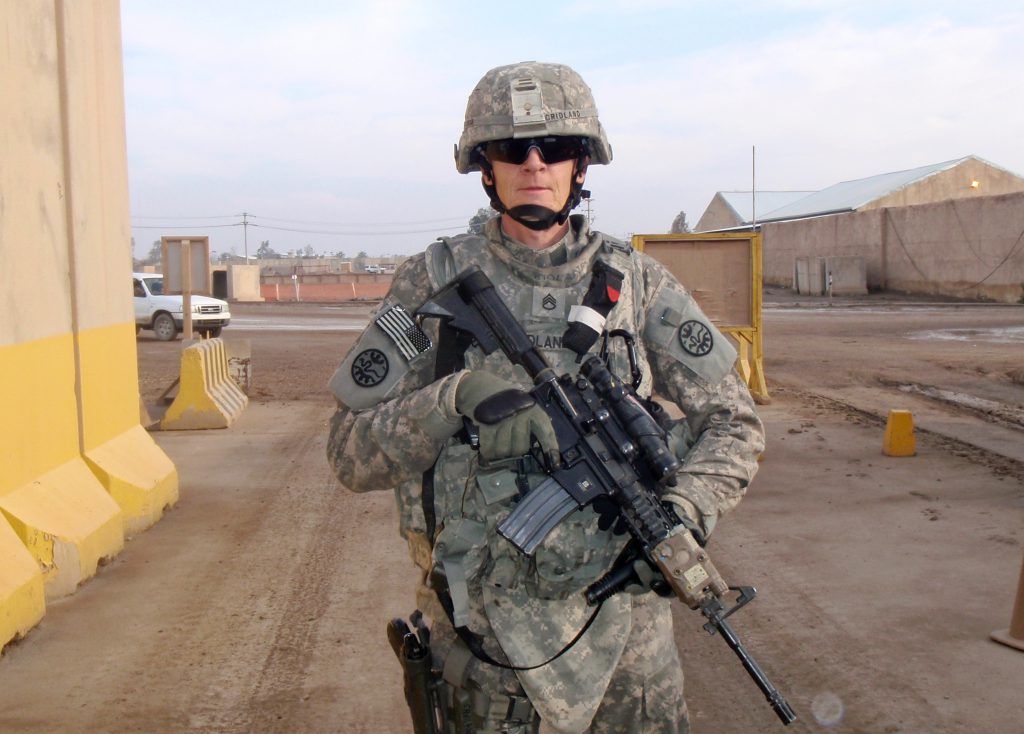
Idaho Military Division Public Affairs/Maj. Robert Taylor
Cassandra Cridland has known her husband, Sgt. 1st Class Wayne Cridland, since junior high.
“The thing to know about my husband is he’s just committed to life,” she said. “Whatever he’s doing in the moment, he’s fully committed to that. If he says he’s going to conquer something, you might as well stand out of his way. He’s going to do exactly that. Whether it’s cancer, going on a deployment or mowing the yard.”
Cridland was diagnosed with Stage 4A squamous cell carcinoma in February 2009. In September 2010, he deployed to Iraq with the Army National Guard’s 116th Cavalry Brigade Combat Team in support of Operation New Dawn.
“That’s what we train to do,” Cridland said. “As an NCO, I didn’t want another NCO leading my guys into combat and being responsible for them. If something happened to them, I didn’t want that responsibility on someone else’s shoulders who hadn’t spent a lot of time with them.”
Cridland said the cancer started in his left tonsil and then spread to the left side of his face, jaw, tongue and neck. His doctors proposed an aggressive treatment plan that gave Cridland an 85 percent chance of surviving. For eight weeks, Cridland was to receive radiation every day and chemo every Monday for five hours. Cridland said he had an IV port inserted into his heart to accept the chemo because the heart’s vessels are bigger than other blood vessels, which allows them to handle more damage from the chemo.
At seven weeks, Cridland said the treatment was causing him more harm than the cancer was, so his doctors had him take a week off. At that time, his chances of surviving dropped to 14 percent.
Cridland finished the last week of treatment in June and said he was given six months to live. He had shrunk in size from 190 pounds to 124 pounds while receiving treatment. He had a feeding tube for nearly three months because scar tissue from the radiation made it impossible for him to swallow. After it was removed, he had to learn to chew and swallow again. His doctor wasn’t sure he would be alive for Christmas. Cridland had other plans. He quickly went back to work and working out.
“I told him I didn’t have time for that and I was too dumb to die,” he said. “My wife absolutely wouldn’t let me quit. Every time I got down, my wife was there to remind me I had things to live for and keep me going.”
Cassandra said she deals with stress by walking and that while Cridland slept after treatment, she’d walk nine or 10 miles a day.
Cridland said he only missed drill once due to the cancer. He was hellbent on deploying with his unit, B Company, 145th Brigade Support Battalion, even as doctors told him they didn’t think it was possible.
“By the time he finished treatment, he needed something he could face head on,” Cassandra said. “He was completely out of control of the outcome of his treatment and he needed something he felt like he had some control over and I respected that. The deployment was something he needed. Doctors kept telling him he wasn’t going and he kept saying, ‘yes I am, just watch me.’”
Cridland said he argued with his doctors to clear him to deploy.
“I said, ‘if you can’t give me a medical reason why I can’t deploy, you need to deploy me.’ I think it was because I kept bugging them, they gave in and let me go. There was no medical reason for me not to go.”
Cridland deployed with the rest of the 116th Cavalry Brigade Combat Team in September 2010. The brigade trained at the Orchard Combat Training Center in Boise and at Camp Shelby, Mississippi, before deploying to Iraq.
ONE A SOLDIER, ALWAYS A SOLDIER
Cridland enlisted into the Idaho Army National Guard in 2007 as a 91B wheeled vehicle mechanic. He previously served in the U.S. Army from 1985 to 1991. After a divorce that left him with primary custody of three children under the age of five, he decided to get out of the Army. With his children grown and 9/11 still on his mind, he joined the National Guard.
“I’m from that age group where you don’t attack America and get away with it,” he said. “I was still young enough to come back in, so I reenlisted.”
Cridland was nearly 40 at the time. He said he showed up to the recruiting station with long hair and no one thought he was serious about enlisting until he produced his DD-214, indicating he had previously served.
“I like serving my country and knowing we’re making a difference,” he said. “In the National Guard, we can serve the public with snow removal, firefighting support and those type of missions, and we’re available for combat if we’re needed. A lot of it is just giving back to the community and supporting them when they need us.”
Cridland said the biggest difference between serving in the 80s and post-9/11 was the Army’s change of mission. Cridland was a mechanic for an infantry line unit during his first stint in the Army. He said training focused on defeating Russia in the Cold War. His mission in Iraq was largely convoy security and escorting VIPs in an urban environment.
Cridland was a squad leader during the deployment as his unit conducted more than 260 convoys along the 17-miles between Camp Victory and Baghdad’s Green Zone. For most missions, he was the convoy commander with 11 other Soldiers. He said most days were uneventful, with one exception.
On July 7, 2011, part of his team was hit by an IED, which claimed the lives of Specialists Nathan Byers and Nicholas Newby. The Soldiers were the brigade’s only two causalities during the deployment. Byers was 24. Newby was 20.
“I had known Byers for quite a few years,” he said. “That hit me hard. He was a good kid.”
Cridland, and the other part of his team, responded to the scene in just minutes to assist with fire support and security.
During the deployment, Cridland checked in monthly with the local aid station to have his throat inspected once a month to ensure the cancer hadn’t grown back. It still hasn’t grown back, though he lives with what he describes as low-grade pain all the time due to the damage the chemo caused his muscles and joints. His heart and lungs are both scared as a result as well.
Cridland’s two sons also deployed with his company. They were assigned different missions to prevent the family from being involved in the same mass casualty event. Cridland would see his oldest son, Michael, occasionally and his youngest son, James, fairly often as they were located at the same staging area.
While the three were deployed, Cridland’s daughter got engaged and planned her wedding for the day after her dad and brothers were scheduled to return home. Cassandra said she ended up having to delay the wedding by two hours but as soon as the three got home, they changed and Cridland walked his daughter down the aisle.
Cridland said it felt good to be home and that the loss of two Soldiers just weeks before still weighed heavily on his mind without any real closure. He took 45 days off and then went back to work.
‘THERE’S MORE HERE THAT I JUST HAVE TO DO’
Cridland said early into his diagnoses, he went to his company’s first sergeant and told him he had cancer and that he didn’t want to get out of the National Guard. Cridland doesn’t know what decisions were made at higher levels, but said his first sergeant and his unit fully supported him and his decision to deploy.
“As long as I was making progress, they kept working with me,” he said.
Cridland said since recovering from cancer and returning home from a deployment, he has become a lot more focused on his relationship with his wife and pursuing his goal to be promoted to first sergeant of the only company he’s served in since 2007.
Cridland met Cassandra in junior high. His now brother-in-law introduced the two because they were both in the school’s band and enjoyed reading. They became friends but didn’t start dating until 1993, after both had married and divorced other people.
“After three years, we decided we probably should just get married because we found a friendship and companionship that felt like a lasting thing and not something that is temporary,” he said. “We work really hard to get through things and not give up.”
“She kept me going. I didn’t want her to end up spending the next 30 to 40 years around without me around.”
After the deployment, Cridland took his wife to Scotland. The two hiked 138 miles in 12 days. He also found a job much closer to his home in Sandpoint, Idaho. He now works as a diesel mechanic for a local mining company. He had previously worked in Wyoming and traveled back and forth during the month.
“I don’t let things worry me as bad as they used to,” he said. “I use to have this since of urgency about everything, now I pick and choose what gives me that sense of urgency. I take things as they come now.”
He plans to stay in the National Guard for as long as he can. He’s currently 54 and could have retired two years ago, but as much as he enjoys his civilian job, he enjoys being around Soldiers more. He plans to deploy with the 116th Cavalry Brigade Combat Team in 2022.
He’s completed his military education and is his company’s combatives instructor and resilience trainer, efforts he’s made to learn as much as he can while he still serves.
“I had a college teacher who said once you have knowledge, no one can take it from you,” Cridland said. He said whenever you have the opportunity to learn something, you should learn it because then you own it and no one can take it.”
Cridland shares his story with members of his church whenever he can. He tells people not to give up when they are going through tough times. He tells people to keep fighting, knowing he’s made it through his worst days and is around to see his children have children.
“I’m not afraid to die, I just felt like there’s more here that I just have to do,” he said.
Idaho Guard partners in multi-agency all-hazards exercise
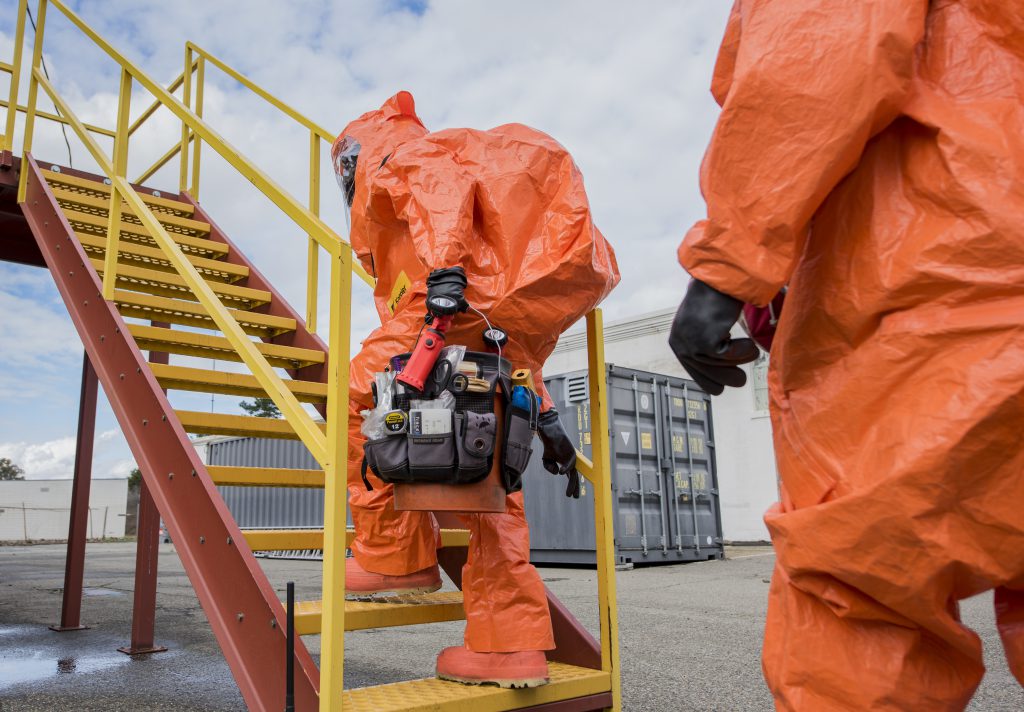
Crystal Farris/Idaho Military Division Public Affairs
The Idaho National Guard’s 101st Weapons of Mass Destruction Civil Support Team partnered with CSTs from 11 other states, along with more than ten different local and federal agencies and organizations, during Exercise ORCA 2021, to train in responding to various hazardous material incidents throughout Alaska, May 17 to 20.
The all-hazards exercise that took place simultaneously in Anchorage, Matanuska-Susitna Valley and Seward, involved the largest turnout of CST participants to an ORCA exercise, helping the 101st CST and other emergency responders maximize training opportunities while testing interagency coordination, interoperability and response abilities.
“It is important that we practice deployment operations and integration with other teams through exercises to ensure a rapid, timely and integrated response to a real-world threat,” said Capt. Jessica McBride, 101st CST survey team leader.
During the exercise, CSTs coordinated and worked through various scenarios, including identifying illicit and dangerous substances and responding to simulated attacks and disasters.
The 101st CST responded to the Anchorage Fire Training Center, which for the exercise simulated a residential six-story apartment building with approximately 20 rooms where terrorists prepared weapons of mass destruction.
“We were called in to conduct a relief-in-place of Alaska’s 103rd CST after it established perimeters with safe zones and threat zones, and then started site characterization of the building itself,” said Capt. John Bomsta, 101st CST operations officer. “We assisted in finishing the site characterization, describing what the building looked like and the possible threats we found. There was something to be found in every room and a lot of area to cover.”
Once on scene, the 101st CST worked through the night for approximately 12 hours continuing site characterization and field analysis of the building. During that time, it located five lab setups including a drug lab, a homemade explosives lab and a potential nerve agent lab. Rooms also had trips wires, motion detectors and confined spaces.
“We were able to provide field analysis of what we saw in the building in order to push information up to higher, which in this case was the FBI as incident command, on what they should look for at other sites,” said Bomsta. “As the story developed, other CSTs were located as far south as Seward, also responding to various terrorist threats in their vicinities.”
CSTs from Alaska, California, Connecticut, Colorado, Ohio, Oregon, Rhode Island, South Carolina, South Dakota, Washington and Wisconsin attended, in addition to other National Guard units such as Colorado’s 8th CBRN Enhanced Response Force-Package and members of Alaska’s 176th Civil Engineer Squadron.
Local agencies and organizations included Alaska Department of Homeland Security and Emergency Management, Matanuska-Susitna Emergency Management, Alaska Department of Environmental Conservation, Major Marine Tours, Alaska Railroad, Anchorage Fire Department, Alaska State Emergency Operations Center, University of Alaska-Anchorage, Port of Seward and the Port of Alaska-Anchorage.
“The exercise was designed with scenarios based on what all the participating CSTs had communicated they wanted to see and tasks they wanted to accomplish,” said Maj. Robert Grimes, 101st CST commander. “Our team was able to achieve various objectives, including integrating with other CSTs and civil responders to build those relationships and learn each other’s capabilities and limitations.”
Unlike most other military units, CSTs work almost entirely alongside civilian agencies, including regional hazardous response teams, police, firefighters and other state or federal responders that function under an incident command system during emergency situations. Grimes said developing these partnerships make training scenarios like Exercise ORCA 2021 critically important.
“What we do as an individual team is just one portion of what it takes overall to respond to a real-world event like this,” said Grimes. “We train to provide the best support we can to civil authorities in the event of a domestic chemical, biological, radiological or nuclear high-yield explosives incident.”
As one of 57 teams located in every U.S. state and territory, the 101st CST is composed of 22 highly skilled full-time Army and Air National Guardsmen trained to provide incident and disaster management by identifying CBRNE agents and substances, assessing current or projected consequences, advising on response measures and assisting with appropriate request for additional follow-on state and federal military forces.
As part of Idaho’s emergency response structure, the unit is prepared and ready to respond at any time to hazardous incidents that threaten the community, state and nation and are often called upon state-side to assist in public safety events including sports games and governor inaugurations.
From the ground to the sky: Idaho’s joint fire exercise
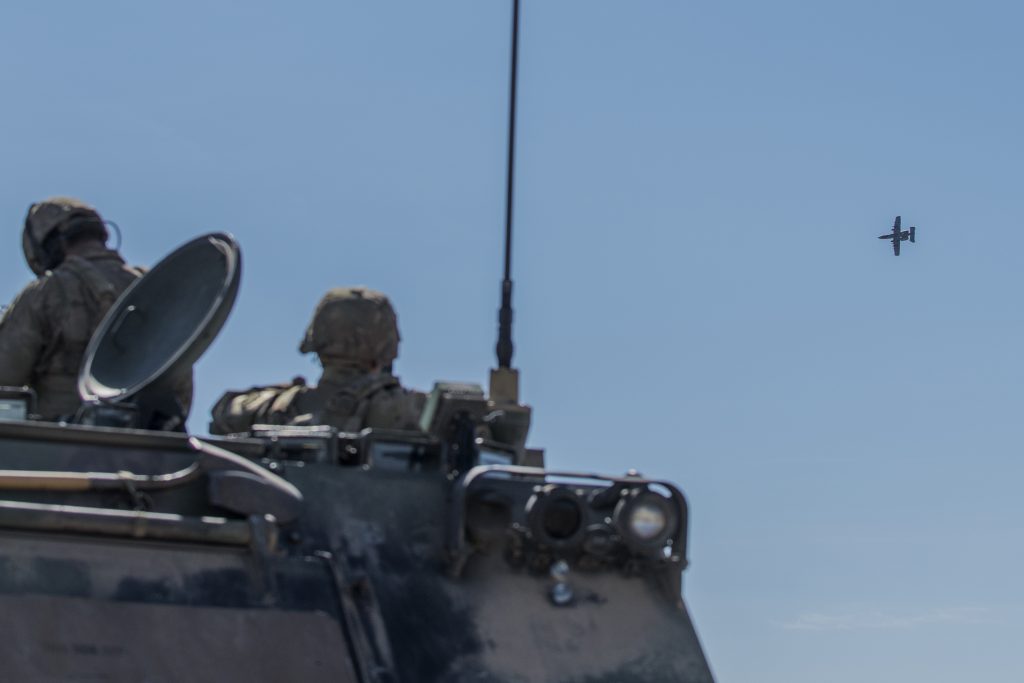
Master Sgt. Becky Vanshur/Idaho Military Division Public Affairs
Idaho citizen-Soldiers and Airmen trained together May 18-19 to support a joint fire exercise that combined live mortars from the ground with close air support from above. Included were live bombs, missiles and combined effects munitions at Idaho’s premier training location, the Orchard Combat Training Center.
The Idaho Army National Guard’s 2nd of the 116th Combined Arms Battalion and the Idaho Air National Guard’s 124th Air Support Operations Squadron and 190th Fighter Squadron joined forces from the ground to the sky in the large-scale joint training event.
“Our battalion hasn’t had this level of training or this level of interoperability working with the Air Force before,” said Maj. John Gregory, 2-116 CAB operations officer. “We want to get to that level of proficiency working with each other, Army and Air, and provide ourselves the most lethal amount of force and mass effects in one space, at one time.”
Integrating the Idaho Air National Guard to bring combined effects on the battlespace started two years ago with dry run munitions. This year the exercise combined live munitions. 124th ASOS joint terminal attack controllers worked with the 2-116 CAB’s joint fire observers to direct targets with combined live-fire weapons engagement.
Idaho’s A-10 Thunderbolt II aircraft dropped 500-pound bombs and other munitions in close air support for a combined effect after the ground forces engaged with the 120-millimeter self-propelled mortar explosives. This is the first time the A-10s dropped the live bombs at the OCTC as airpower support for the Idaho Army National Guard.
“Joint live-fire integration is the key to success on the battlefield of tomorrow,” said Brig. Gen. Timothy Donnellan, Assistant Adjutant General – Air. “The Soldiers and Airmen of the Idaho National Guard will continue to train together following the National Defense Strategy. The live-fire integration training conducted will give the ground commander the confidence they need to dominate the battlespace of the future aggressively.”
A variety of weapon platforms and munitions are used to attack enemy air defenses through the U.S. Department of Defense’s concept of suppression of the enemy air defense, or SEAD mission.
“We want to build on this training and make it a grander concept over the years to come,” said Capt. Jacob Bartlow, 2-116 CAB assistant operations officer. “We settled on a concept of the SEAD mission. This training turned out to be a great run and integrated all three units.”
The training will continue to become more robust each year. Bartlow plans to have several iterations of close air support from the A-10s in the future and possibly integrate F-15s from Mountain Home Air Force Base to support SEAD.
“In future joint fire exercises at the OCTC, we can include scouts to identify the enemy, bring in artillery, mortars and air defense to suppress the capabilities of the enemy so we can free the maneuver in another portion of the battlespace,” said Bartlow.
Located 18 miles south of Boise, Idaho’s OCTC has 143,000 acres of vast terrain and world-class ranges with a four-season climate, making it ideal for preparing units for combat in a challenging and realistic training environment.
“We have incredible training space here at the OCTC,” said Bartlow. “Ultimately, we envision Idaho as the National Guard’s premier location for joint fire integration.”
Idaho Guardsman, mother sets example
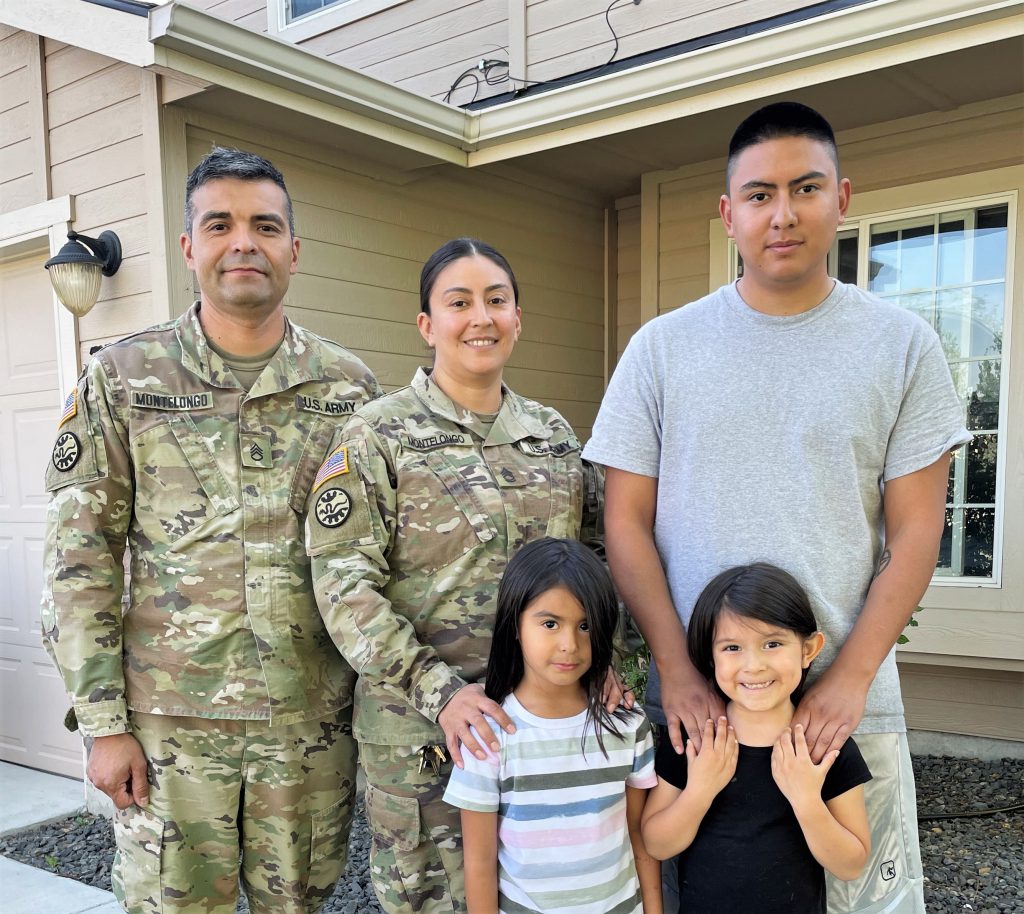
Idaho Military Division Public Affairs/Crystal Farris
Sgt. 1st Class Gladys Montelongo was a single mother raising three children and managing a Subway restaurant when she decided to change career path and join the Idaho Army National Guard at 28 years old in 2009.
“I felt I had more to offer and wanted to be a positive role model for my kids,” she said. “I knew joining the Guard would provide opportunities for myself and my family.”
Through the Idaho Guard, Montelongo has since received approximately $55,000 in enlistment and reenlistment bonuses; purchased her first home using a VA home loan; met her current husband and used her military tuition assistance to earn a bachelor’s degree at Boise State University.
“Before joining, I never imagined having the means to buy a house or earn a degree,” she said. “The money and opportunities are available in the Guard. Joining has helped me provide for my family and motivated me to do better.”
In April, Montelongo was promoted to sergeant first class as the culinary management noncommissioned officer for Golf Company, 145th Brigade Support Battalion.
She is also currently pursuing a master’s degree in legal studies at the American Military University. Montelongo said continuing her education and career advancement sets the right example for her four children and also the 11 Guardsmen who she manages at work.
“Being a mother and an Army leader is similar in my mind,” she said. “I show my kids the value of hard work and dedication and push them to be the best in what they do, just like I push my Soldiers to be the best they can be.”
One of Montelongo’s children currently manages a Little Caesar’s restaurant in Lewiston, Idaho, while her oldest son serves in the Idaho Army National Guard as a specialist with the organization’s 148th Field Artillery Regiment.
“Seeing my son follow in my footsteps gives me a proud feeling as a parent,” said Montelongo. “I believe my work ethic and service has positively contributed to his decisions.”
Although some aspects of leading a family and a group of troops overlap, leading Soldiers can be a lot different than managing individuals in a civilian job, she said.
“The difference between managing a Subway restaurant and a culinary section in the military is that I’m responsible for the wellbeing and career development of my subordinates,” said Montelongo. “My troops are a reflection of my leadership, which I provide through on-the-job mentorship, training and counseling.”
Montelongo developed her leadership through years of experience as a senior food service specialist and while in Army leadership courses, where she learned to provide Soldiers purpose and fulfillment, she said.
“I take the time to get to know my Soldiers and what motivates them,” said Montelongo. “I look out for them, make sure they have what they need and advocate for their best interests. When everyone feels good, they do good things and that’s the rewarding part.”
While preparing large-scale meals for hundreds of Soldiers during training, including in field environments from mobile kitchens, she also provides her subordinates with motivation by getting in the kitchen and showing them how to spice up recipes using bacon or rubs made from scratch.
“The job is demanding and its hard work, but very rewarding,” Montelongo said. “As cooks, we work early mornings and late nights preparing and serving meals, but Soldiers look forward to seeing us and getting a hot meal in the field. It’s a nice feeling knowing we get to provide that to them, so we make it fun and ensure the food always tastes good.”
Idaho National Guard, Idaho Army National Guard, National Guard, 145th Brigade Support Battalion, Mother’s Day, Women’s History Month
Idaho Guardsman ranks top Guard team in Best Ranger Competition
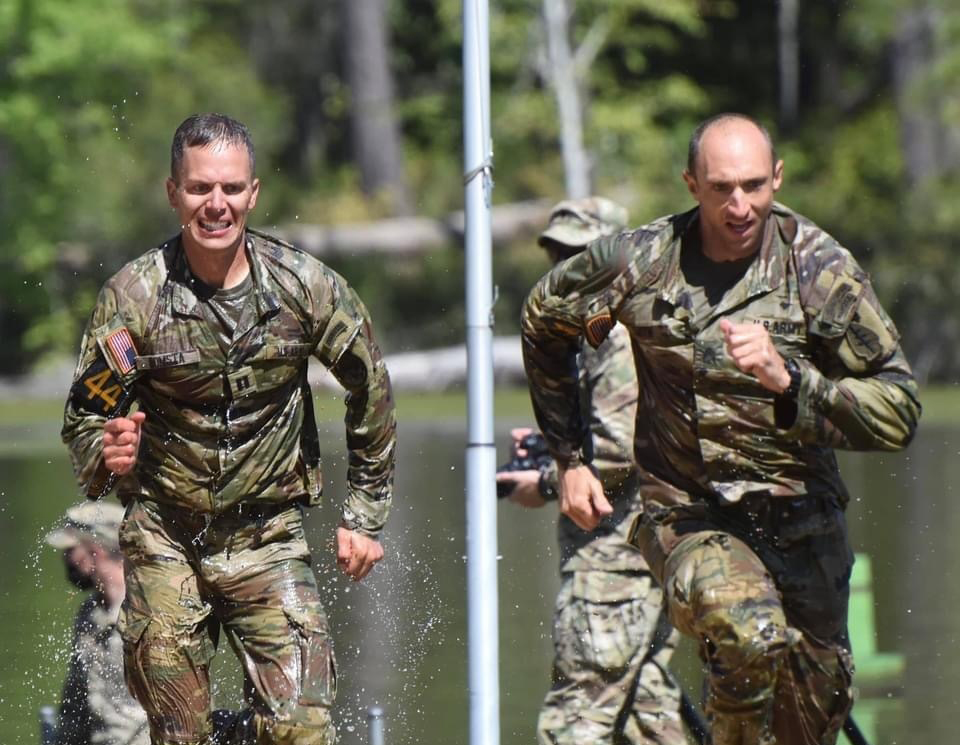
Idaho Military Division Public Affairs/Crystal Farris
Idaho Army National Guardsman Capt. John Bomsta and his teammate, Sgt. 1st Class Nathan Smith from the West Virginia Army National Guard, were the top National Guard team and 10th out of 51 U.S. Army teams at the Best Ranger Competition April 18.
1st Lt. Christian Briggs, also in the Idaho Army National Guard, competed and placed 28th with his teammate, Spc. Jerry Marksbury from the Kentucky Army National Guard.
“Our Soldiers did an incredible job representing the National Guard and the Idaho Army National Guard at this year’s Best Ranger Competition,” said Brig. Gen. Farin Schwartz, assistant adjutant general – Army. “Their physical and mental perseverance is a testament to the quality of Soldier that makes up our great organization.”
It was the first time any Soldier from the organization had participated in the Best Ranger Competition since it started at Fort Benning, Georgia, in 1982. The competition determines the best two-Soldier team based on their performance through a series of physical and technical events day and night.
“This is truly a team event,” said Bomsta. “Similar to combat, you have to find strength in one another to keep going through your most vulnerable moments. My teammate was a brave man and, like me, would not quit. Finishing with someone of his caliber made the competition that much better.”
In addition to being Ranger qualified, Guardsmen must try out to place on a team and, if they advance, complete a three-month training course leading up to the competition. The course provides each Guardsman time to effectively train for the events and learn to work as a team, said Bomsta.
In September 2020, he made it through tryouts at Fort Benning and returned to attend the train-up course in January. Bomsta, Briggs and their teammates were four of 16 National Guardsmen who competed.
When he returned for training, Bomsta moved to an apartment in Columbus, Georgia, with his wife and four children. Having his family there at the end of each day provided much-needed support, Bomsta said.
For the next three months, his team trained with coaches 10 hours a day to prepare for the vigor of the competition. In the first few weeks alone, Bomsta said they walked almost 50 miles a week training on obstacle courses, in land navigation and during foot marches.
“We worked every day through the pain to prepare,” said Bomsta. “The competition had been a lifelong dream for us. We are both 34 years old and knew this could be our only shot. We formed a successful team by communicating our end goals and giving it our all to achieve them.”
The competition included a foot march, an obstacle course, a land navigation course, a buddy run, weapons qualification, combat water survival and infantry tactics. At the beginning of the competition, the particular events and order of events were unknown to participants.
“The first day opened with about an eight-mile run,” said Bomsta. “We ended that day with a foot march of more than 19 miles. The next day consisted of technical tasks, like shooting, repelling and mountaineering. On Day Three, we had the obstacle course, water assessment, more shooting and a final buddy run.”
Families and other spectators cheered on participants and observed some of the events. Bomsta said having his kids there was motivational and an opportunity to show them what hard work can do.
“To have my children see me do something hard and push through the pain was an awesome opportunity for a father to have,” said Bomsta. “Hearing them cheer me on picked me up and pushed me harder because there is plenty of need to be picked up in this competition.”
With little sleep over three days, Bomsta said he and his teammate struggled to stay sharp, especially during the technical tasks on the second day.
“We knew it was going to be a challenging competition,” said Bomsta. “We went in with a game plan to stay fresh for Day Two by not wearing ourselves out on the first day. We stuck with that plan for all of a couple hours until we got caught up in the excitement.”
By the end of the first day, Bomsta said his team did well on the weapons ranges and was fourth in the competition, which helped them push through the late-night foot march.
At that point, the teams in the bottom half were eliminated from the competition.
“Day Two was somewhat of a low point and cost us the opportunity to win the competition,” said Bomsta. “We were physically hurting, had no sleep and got complacent through the technical challenges. The land navigation course later that night turned into a second foot march and we ended up walking another 13 or so miles. In that moment, we just had to motivate each other to get through it.”
Some of the technical tasks performed the second day included treating an injured pilot while under fire before moving to an evacuation point, completing a hand grenade assault course, and assembling a mortar system on a bipod.
Although it was hard, the third day was better, Bomsta said.
“Just knowing we made that first cut gave us motivation to complete the competition,” said Bomsta. “We were so exhausted and the hard part was really maintaining focus. By the last event, which was a two-mile buddy run, I could almost taste the finish line. Once I crossed it, I had the biggest relief that it was over. I went straight to my family and collapsed in their arms.”
Guardsman honors father, retires as Idaho’s first woman staff judge advocate
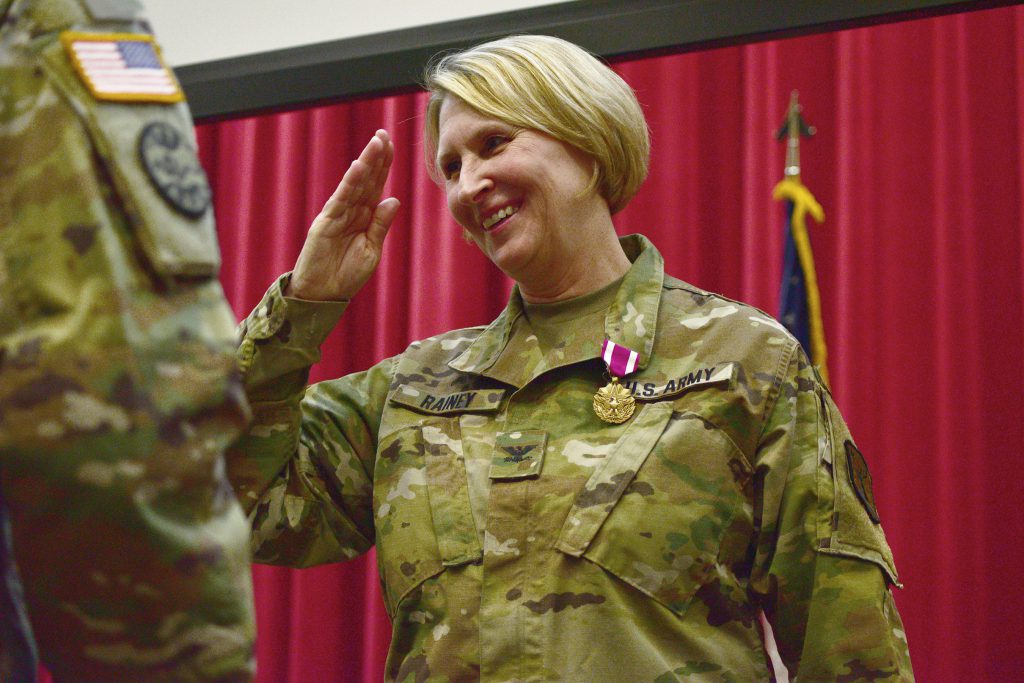
Idaho Military Division Public Affairs/Crystal Farris
Col. Lora Rainey joined the military like her father and made it a goal to honor him by reaching the same rank he did while serving.
After 24 years in the Idaho Army National Guard and accomplishing her goal to earn the rank of colonel, Rainey retired on April 17 from the organization as its senior female officer and the first female state staff judge advocate.
“My promotion to colonel was really special to me,” said Rainey. “I wanted so badly to get to the point my father did. I know he’d be proud of me for all I’ve accomplished.”
Rainey was promoted to Colonel on Nov. 30, 2017 in a ceremony held at Gowen Field’s John W. Rainey Hall, a building dedicated to her father. He served on Gowen Field as a colonel and commander of the Army Reserve’s 321st Engineer Battalion and later passed away in 1985. Rainey asked to have her ceremony there to honor his memory.
“My father loved the Army deeply,” said Rainey. “I wanted to reconnect with him in that moment to thank him for instilling in me his love for the military and for setting me on the path years later that led me to where I am now.”
Before Rainey commissioned into the Idaho Army National Guard in 1997, she graduated law school from the University of San Diego in 1994. After returning home, she was reminded of the Guard’s opportunities and reflected back to her father’s love for serving.
“After law school I heard about a judge who had been a JAG officer on Gowen Field,” said Rainey. “He talked about the Guard being an incredible opportunity and a perfect supplement to a civilian career. It was a combination of those stories and remembering my father’s love for the military that made me look into the organization myself.”
After joining, Rainey said she appreciated having the ability to focus on one area of the law in her civilian career and another more varied one in her military career.
She and two colleagues established their private law practice Breen Veltman Wilson PLLC in 2012, as one of Idaho’s few all-female-owned law firms, Rainey said. They represent employers’ and insurance carriers in workers compensation matters.
“In my civilian practice I only do one type of law and that’s terrific because it allows me to be a true expert in that field,” she said. “With the military, there are so many areas of law you need to address like military justice, fiscal law, the law of war or the law of armed conflict. It’s really exciting and I’ll miss that multifaceted approach you get to take as a JAG officer.”
As the state judge advocate, Rainey advised the Idaho’s command staff on legal matters and oversaw all legal services provided within the organization. As a JAG officer, Rainey counseled and represented service members at all levels concerning legal matters pertaining to themselves, their families and the organization.
“As I reflect on my career, I can say confidently that both of those jobs were instrumental to the organization. I got to help troops meet goals, military families make positive strides and assist commanders make sound legal decisions.”
Throughout her career, Rainey said her most memorable moments included serving as deputy staff judge advocate during a deployment to Kirkuk, Iraq, in 2004; serving as the 116th Cavalry Brigade Combat Team’s staff judge advocate after returning from deployment; and later standing up the Idaho Army National Guard’s first trial defense service team.
The trial defense service provides legal representation to service members while enabling JAG personnel to advocate for their clients in an objective and independent manner, Rainey said. She first implemented the program after a National Guard directive in 2000, by educating commanders on the new service and emplacing reporting procedures.
“Once JAG is put into the trial defense slot, they have a completely different chain of command outside the Idaho Guard,” she said. “The great thing about that is it bolsters our ability to adequately and effectively represent troops with more independent representation and less conflicts of interests.”
Being able to advocate for her clients is what Rainey enjoys most about her career, she said.
She first decided to become a lawyer while spending a year in Washington, D.C. working for the U.S. Department of Veterans Affairs. It was the year after she graduated from the University of Redlands in California with a bachelor degree in political science and economics.
“Working with attorneys and being around so many legal issues there pushed me toward law,” said Rainey. “I realized how many employment opportunities there were within the field and that’s when I decided to apply for law school.”
While she has enjoyed both a military and civilian career, Rainey has also dedicated almost 30 years to volunteering within the community. She has served on the Idaho State Bar’s Volunteer Lawyers Program and Fee Arbitration Program, Ada County Youth Court, and on boards for both the Idaho Legal Aid Services and Anser Public Charter School.
In 2007, Rainey was honored with the Idaho State Bar’s annual Denise O’Donnell Day Pro Bono Award for donating extraordinary time and effort to help clients who were unable to pay for services. She was later selected by Idaho Women Lawyers to receive its Bertha Stull Green Award in 2018, which honors women within the legal community who demonstrate commitment to their community and public service.
Upon receiving her certificate of retirement from the U.S. Armed Forces and the governor of Idaho, Rainey was also honored with the Meritorious Service Medal for her dedication to service in the Idaho Army National Guard.
“It’s bittersweet,” she said. “The Guard has been such an integral part of my life. I will miss working with the troops and the incredible group of JAG professionals I’ve been privileged to know.”
Siblings serve in Idaho Guard as Citizen-Soldier, Airman
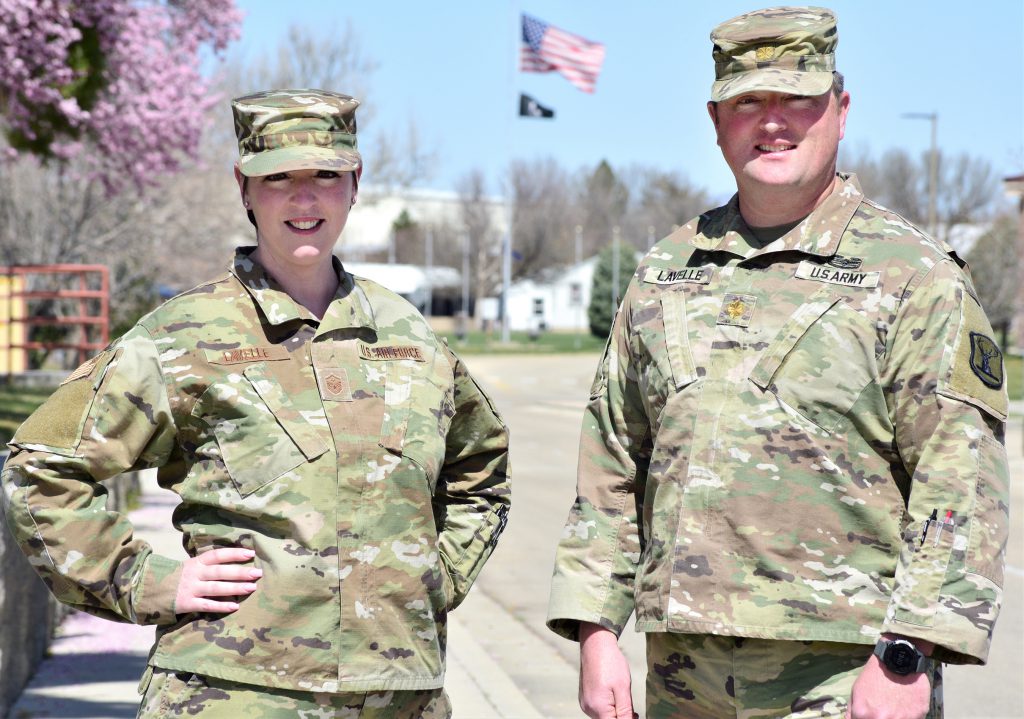
By Crystal Farris/Idaho Military Division Public Affairs
Maj. Christopher Lavelle and his younger sister, Master Sgt. Kerry Lavelle, are known on Gowen Field as “the Lavelles.” They have served on base as full-time technicians for several years and as traditional Guardsmen in the Idaho National Guard for nearly 20 years.
“It’s been fun serving in the military at the same time as my family,” said Christopher. “It seemed at one point that everyone on base knew who we were. They would see Kerry when she used to work in security forces at the front gate and they would see me for computer problems at the communications office.”
Joining the Guard was not something they planned to do together but was something they both ended up doing to pay for school. Coming from a family with four other siblings, Christopher said his dad could not afford to send them all to college. Serving in the military was a way to receive education assistance.
“Kerry and I weren’t confident in what we wanted to do in our lives or how long we would stay in the military,” he said. “We both ended up serving almost 20 years and having successful careers within the Guard.”
“I joined to pay for school, but I chose the Air Guard because my brother was in the Army Guard,” Kerry said. “I couldn’t join the same branch as him; I had to do something different.”
Christopher enlisted into the Idaho Army National Guard in June 2000 as a signal operations specialist after graduating from high school in Boise. A year later, Kerry graduated from the same high school and enlisted into the Idaho Air National Guard as a security forces Airman.
After returning from training at Fort Benning, Georgia, Christopher deployed to Bosnia with the 183rd Aviation Regiment in 2002. He later joined the 116th Cavalry Brigade Combat Team and deployed to Iraq in 2004. The next year, he reenlisted and started work as a full-time technician for the Idaho Army National Guard.
He served nine years as an enlisted Guardsman, became a sergeant, enrolled in officer candidate school and commissioned as a signal officer in 2008. The same year, Christopher earned bachelor’s degrees in criminal justice and political science from Boise State University.
“It took a long time for me to finish school between two deployments,” said Christopher. “I reenlisted because I wasn’t done with what I started and wanted to complete school. I later decided that if I was going to stay in, I wanted to commission.”
Kerry and her younger sister, Caitlin, who also served in the Idaho Army National Guard from 2004 to 2011, attended Christopher’s commissioning ceremony on Gowen Field.
“We were really proud of him,” Kerry said. “We both raced to the stage wanting to be the first to salute him, but Caitlin pulled off my hat to slow me down and ended up winning.”
In 2010, Christopher deployed again to Iraq as a platoon leader with the 148th Field Artillery Battalion. Since returning, he has served in various positions in the Guard, including company commander and signal officer for both a battalion and brigade staff.
He now works as a full-time technician and data processing manager for the United States Property and Fiscal Office and serves part time as a traditional Guardsman and the staff communications officer for Joint Force Headquarters-Idaho.
When Kerry went to Lackland Air Force Base in San Antonio, Texas, for basic military training in 2002, Christopher stayed in touch through letters.
“I remember my brother sent me postcards and pictures,” Kerry recalled. “He was in Salt Lake doing security for the Olympics and sent me a picture of him standing on his bunk with the bed all messed up. He joked, ‘How is basic training going? Good thing you are learning how to make a bed.'”
Kerry returned home in June 2002 and was activated, along with most of the 124th Security Forces Squadron, to provide increased security on Gowen Field after 9/11. She attended school and served intermittently on active duty orders as part of security forces on Gowen Field and Mountain Home Air Force Base until reenlisting in 2007.
“I decided last minute to stay in because the military was the one consistent thing in my life,” said Kerry. “I figured it would be a good decision, and it was.”
Kerry deployed to Saudi Arabia for six months with the 124th Security Forces Squadron in 2008. In 2010, she earned a social sciences degree in general studies from Boise State University and three years later left for Korea.
“I wanted to do something different just for a little while,” said Kerry. “I decided to travel to Korea and teach English for two years. It was fabulous. I also met my husband there, who laughs when I tell people he’s my favorite souvenir.”
Kerry returned home in 2015 and continued work in security forces until becoming the first sergeant for the wing’s logistics readiness squadron in 2018. That same year, she started a full-time job at the Department of Veterans Affairs. In 2019, Kerry reenlisted for the second time in a ceremony on Gowen Field. Christopher read her oath of reenlistment.
“It was really cool that Christopher was able to reenlist me,” said Kerry. “It makes me laugh thinking about how I messed up the oath because he had given me too many words at one time to repeat from memory.”
Although the two siblings are only 15 months apart, Kerry said Christopher took on fatherly responsibilities at a young age while their father was sick and after he died in 2008.
“My brother has taken on a different role in our family to all of us as kind of a caretaker,” said Kerry. “I’m sure at some point, my dad pulled him aside and told him to look after his family.”
While their father was sick with cancer, Christopher said they had many heart-to-hearts, mostly about taking care of the family.
“He had a big concern for his family and wanted the best for his kids,” said Christopher. “Out of five of us, three joined the military and two are still in. My other sisters also work in public service, so I think we have all done really well, and I know my dad would be proud of us.”
Kerry works in employee labor relations at the VA’s human resources office. In December, she became the first sergeant for the 124th Fighter Wing staff.
Airman serves as Guard flight surgeon, civilian physician
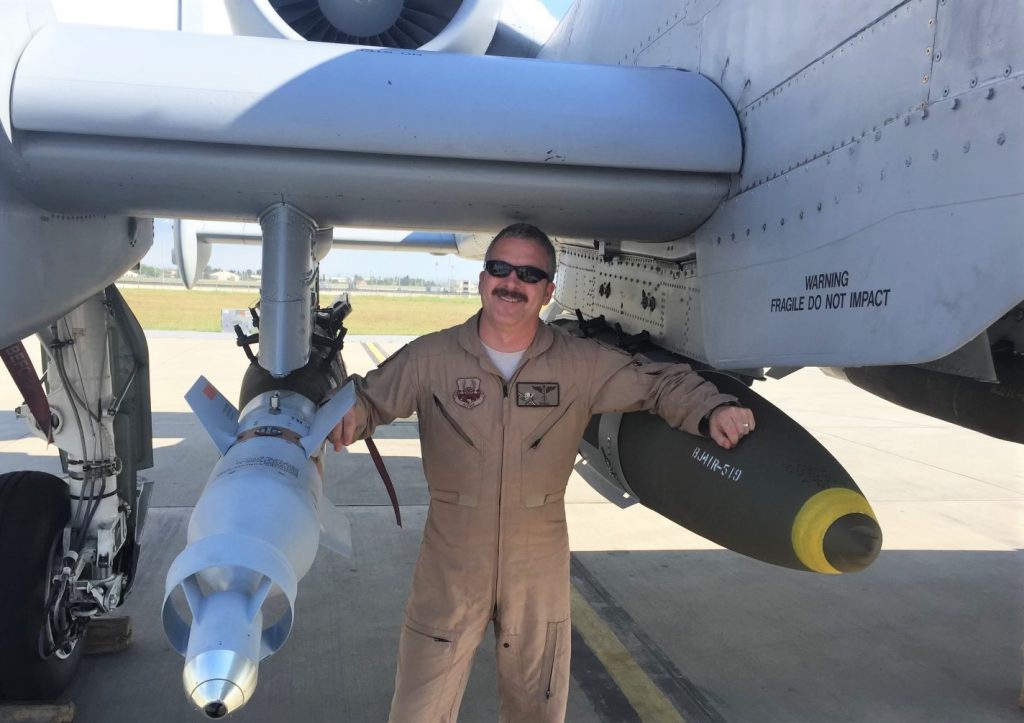
When he was in high school, Lt. Col. Timothy Ruth attended a science exhibition with his parents at a local museum in Minnesota. There was an educational video of an open-heart surgical procedure playing in one of the exhibits. The sight of the video nearly made him ill.
“My mom jokes about how I almost got sick watching it,” said Ruth. “My parents were a bit surprised when I later told them I wanted to go to medical school.”
Ruth was not surprised, however, since his interest in medicine had sparked earlier as a young kid assisting in surgeries and other pet care from his dad’s veterinary practice in their Pennsylvanian home.
He said the act of performing medical tasks was easier for him then just watching them. He also enjoyed the challenge of the field and helping others.
“It seemed to be the perfect career for me,” said Ruth. “Being a doctor meant I got to help people by using what I’ve learned, talents I have and gifts I’ve been given.”
After four years of college, four years of medical school and three years of residency, Ruth became a family practice physician.
Today he serves as a tradition Guardsman and flight surgeon for the 124th Fighter Wing’s 190th Fighter Squadron. He also works full-time as an urgent care provider and senior Federal Aviation Administration examiner for St. Luke’s hospital in Boise, Idaho.
Military first, medical school second
Joining the military was something Ruth wanted to do before he ever considered being a physician. Getting to do both was just the icing on the cake, he said.
After moving from Pennsylvania where he was born, to Minnesota where he graduating high school, Ruth joined the College of St. Thomas’ Air Force ROTC Program in St. Paul.
“I think I always had an interest in the military that started with talking to my grandfather who served as a Seabee in the Navy during World War II,” said Ruth. “It just so happened my college had ROTC, which interested me because it allowed me to try out the military before committing to it.”
Ruth graduated with a bachelor’s in chemistry and a minor in aerospace studies, while also commissioning into the active Air Force as a second lieutenant in 1993. He was then accepted to medical school at the Medical College of Wisconsin, where he received a full scholarship under the Health Profession Scholarship Program.
After medical school, Ruth continued onto his residency at the University of Wisconsin where he specialized in family medicine before starting his eight-year active duty commitment.
In 2000, he received his first duty assignment as a family physician at Grand Forks Air Force Base in North Dakota. Three years later he transferred to Mountain Home Air Force Base in Idaho where he continued to serve in family medicine before attending flight surgeon school and switching to flight medicine in 2004.
The ‘flight physician’
Despite the name, flight surgeons do not perform surgery and do not have to be surgeons. Rather they tend to be physicians of family medicine, emergency medicine, internal medicine or something broader, Ruth said.
Their duties include conducting flight physicals, reviewing medical records, performing physical exams, inspecting work place safety hazards and collaborating with various occupational health programs to maintain the overall flight safety and safety of the organization’s pilots.
“Contrary to the name, you aren’t doing surgery on anyone much less in the air,” said Ruth. “You are a physician and your job is flight safety and taking care of the flyers. A better name for it would be flight physician.”
Since flight surgeons are rated officers and required to perform flying duties, they go through similar survival training as pilots, including water survival, egress and hypoxia chamber training. Going through these types of training, as well as flying with the pilots, give flight surgeons the ability to provide adequate care in their unique situation, Ruth said.
“The medicine that you practice and the things that happen to people at 1g on the ground are very different then what happens to the human body at 9gs,” he said. “When you fly with them, you understand all the physical and physiological demands placed on their bodies.”
After serving another five years in the Air Force, deploying to Ecuador in 2004 and to Afghanistan in 2007 with the 366th Fighter Wing, Ruth left the military completely. The day after he got out and was hanging up his flight suit, Ruth said he had a change of heart and decided to join the Idaho Air National Guard in 2008.
Not ready to hang up his flight suit
“I just wasn’t ready to walk away from that whole unique experience of flight medicine and military comradery,” said Ruth. “Military medicine offers some very unique opportunities that civilian medicine does not, like getting to participate in the whole flying world.”
As a flight surgeon with the Idaho Air National Guard, Ruth collaborates with the organization’s medical group to maintain the flight safety and medical readiness of approximately 50 pilots who fly the A-10 Thunderbolt.
The medical group consists of approximately 80 enlisted and commissioned Airmen who serve as physicians, advanced practice providers, nurses, ER doctors, surgeons and medical technicians. Some serve as ground surgical teams and critical air transport teams, while all are responsible for maintaining the medical readiness of the Idaho Air National Guard’s approximately 2,000 Airmen.
When not serving in the military, many of the Guardsmen work in similar civilian jobs within the medical field like he does, Ruth said. Being able to pursue a civilian career while also serving close to home makes the Guard more appealing then active duty, he added.
“It’s an amazingly diverse group of people,” said Ruth. “All of these Airmen on the civilian side work in everything from ER doctors and cardiothoracic surgeons to fire fighters and police officers. That’s the nice thing about the Guard, you get to do your civilian job but still get to be part of the military. That’s what appeals to me most.”
A civilian physician
On the civilian side, Ruth has worked as a family physician for St. Luke’s since 2008. He currently serves as the director of its urgent care facility in Boise, where he practices urgent care and treats patients with a variety of issues.
“I like the challenge,” said Ruth. “Every person that comes in has a unique challenge or circumstance and if you have the skills to help them it’s very gratifying.”
Within the same facility, Ruth also conducts Federal Aviation Administration examinations for private and commercial pilots who need to recertify their medical credentialing. Like the medical group, many of the Idaho Air National Guard’s pilots also work in similar civilian jobs and fly outside of the Guard.
Ruth said he enjoys getting the opportunity to serve his fellow Airmen and friends on the civilian side, as well as on the military side.
“Most of my friends are pilots and I enjoy having the ability to help them with their annual FAA examinations,” said Ruth. “Civilian FAA exams are similar to military flight exams so it’s a pretty natural bridge from flight surgeon to FAA examiner.”
Last year while deployed to Bagram Air Force Base in Afghanistan, Ruth had the opportunity to use his FAA credentialing to administer examinations to approximately 40 civilian pilots who were unable to return home due to the COVID-19 pandemic and needed to update their medical records.
“It was not something I had imagined doing on a deployment but I was able do that for those people and save them a big hassle in the end,” said Ruth. “It’s just another example of the unique opportunities medical providers get to experience through the Guard while serving others.”
Bilingual Airman helps serve her Spanish-speaking community
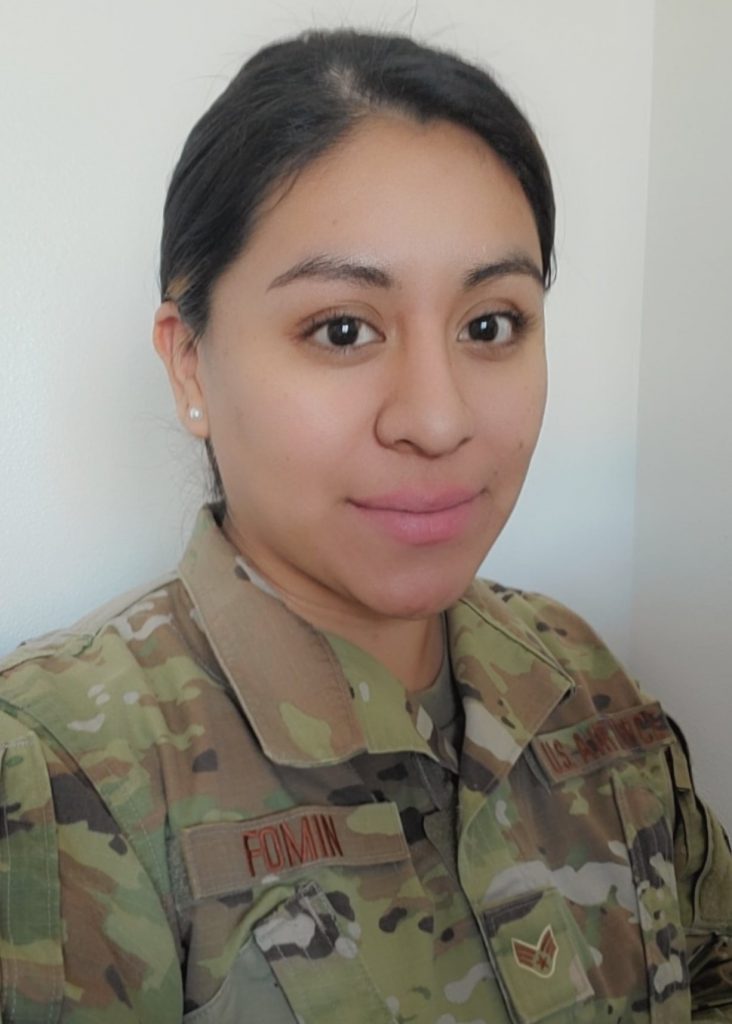
Senior Airman Mayra Fomin was born in Mexico and moved to the U.S. at 4 years old. First living in California and then Nampa, Idaho, her parents raised her to speak both Spanish and English.
After joining the Idaho Air National Guard at age 27 in 2017, Fomin was surprised to have the opportunity three years later to put her Spanish to good use while responding to COVID-19 and serving her community of more than 80,000 Spanish-speaking Idahoans.
“I’ve only been in the National Guard for three years now and I never thought I would use my Spanish in this way,” said Fomin. “It has made me feel so happy to hear the comfort in their voices because they’re able to communicate with someone in their language.”
In December, Fomin was one of several hundred Idaho Guardsmen who volunteered to mobilize to district health centers, local hospitals, health care facilities and medical centers across the state after Gov. Brad Little activated the Idaho National Guard as COVID-19 cases increased.
Fomin said when she arrived at the Southwest District Health in Caldwell, staff there were excited to hear she spoke Spanish. As the only Spanish-speaking service member there, she was assigned to help investigate and monitor positive COVID-19 cases and translate information to the Spanish-speaking community.
“I’m Hispanic and I know for a fact that it’s very difficult for people in my community to understand what’s going on and get the right information out there,” said Fomin. “When the opportunity to volunteer came about, I thought it would be very rewarding to be able to communicate to not only the English-speaking individuals but the Spanish community as well.”
Fomin first joined the Guard looking for a way to serve her community as a traditional Airman. She later took a job as a full-time technician for the command support staff of the 124th Force Support Squadron.
“I thought I wouldn’t be able to volunteer for the mission because I’m a full-time employee,” said Fomin. “I was so excited when my commander gave me the opportunity because it enabled me to go out there and help Idaho however I could.”
It was a rewarding experience to be able to answer questions and concerns from Idahoans who were unable to communicate with them otherwise, especially while consoling members of the community that felt isolated by the COVID-19 pandemic, she said.
Having gotten COVID-19 herself, Fomin said she was all too familiar with the feeling of isolation. Although she had to quarantine from her husband and three children during that time, she said it enabled her to speak from experience while comforting and reassuring individuals who also tested positive.
“Having COVID helped me personally relate to the community and it gave me the opportunity to reassure individuals that their symptoms and health would improve,” she said.
 Official Government Website
Official Government Website